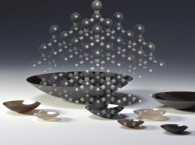
Microspeaker fabrication and assembly is similar to that of buzzers but provides more sound reproduction capabilities. Early microspeakers found applications in portable transistor radios, earphones, headphones, personal computers, video games, and so forth. Mobile audio products have increased microspeaker consumption, especially cell phones, which use a “receiver” for sound reproduction when held to the ear and require a speakerphone function.
Other microspeaker applications include laptops, tablets, and accessory speakers (e.g., Bluetooth speakers and compact docking stations). Similar products and applications have both commoditized and stretched the microspeakers’ sound quality requirements.
Microspeaker Topology
Microspeakers also have some distinct design characteristics compared to minispeakers—no secondary suspension (no damper/spider), typically a one-piece diaphragm (no separate surround or dust cap), and a monolithic self-supporting voice coil (no bobbin). While many mid-sized microspeakers are in the 25-mm (1”) range and round, cell phone design often requires an asymmetrical space and a rectangular footprint is common, especially on the smaller models.
To distinguish between minispeakers and microspeakers, a minispeaker typically has a 2” (50-mm) diameter or greater and microspeakers have a 2” diameter or less. Minispeakers have spiders (dampers) and microspeakers are suspended by their surrounds. Thermoformed film diaphragms, sometimes made of paper and formed fabric diaphragms, can be found in microspeakers’ various sub-classes. The microspeaker’s z-axis (depth) goal is super thin, while minispeakers tend to be larger.
Trends
Some microspeaker manufacturers combine the vibration, ring, receiver, and speakerphone function into a single integrated transducer. However, these functions are more typically split into two or more transducers. The 11-mm × 15-mm rectangular microspeaker dominates the smartphone microspeaker market.
This format has a flat diaphragm and a rectangular voice coil. Many vendors offer drop-in versions, but AAC Technologies Holdings and NXP Semiconductors dominate this market. The response extends down to below 800 Hz (some variants are a bit lower). There are also piezoelectric implementations in this format but the lack of response below 1,400-Hz limits use to “clone” cell phones.
“Clone” cell phones refer to a practice done by many small Chinese cell phone operations. They assemble “kits” of Taiwan chipsets, standard circuit boards, cases, LCDs, cheap mics, and piezo speakers, and the result is a (sort of) “clone” of many popular phones.
There is intense pressure from smartphone designers and the rest of the mobile audio industry to make shallow (Z-axis) microspeakers that are less than 2-mm deep. Added to this is the push for a smaller footprint, higher excursion, lower resonant frequency, and higher sensitivity. (Good luck!) For years, there have been studies trying to use the product casing or LCD panel as the speaker, “digital speakers,” and electret and similar film transducer implementations, but cost, technology, maturity, and infrastructure issues have stalled these breakthrough concepts. AAC’s space-saving innovations that combine multiple functions (e.g., the speaker, the sub-enclosure, and the antenna) into an integrated package appear to be more readily accepted.
More Power!
A related industry push seeks higher output power on both the speakerphone and headphone outputs in smartphones. For example, typical headphone output has increased from 30 to 70 mW and greater.
Speakerphone power also has climbed dramatically, and some sophisticated high-efficiency amplifier topologies are now used in the smartphones’ speakerphone amplifiers to minimize battery drain. Today, new amplifier designs with state-of-the-art speaker load monitoring protection are being introduced for smartphones, providing them with capabilities most concert-sound speaker management processors would envy.
NXP Semiconductors, Maxim Integrated, Texas Instruments (TI), and others are applying every known technique to receive the maximum acoustic output from microspeakers without increasing field failures. With a billion smartphones shipped each year, imagine 10% of them returned for blown speakers!
Who’s Who in Microspeakers
After visiting these factories for almost three decades, Menlo Scientific surveyed and audited many of these vendors. Key players in the microspeaker industry, as well as headphone speaker vendors are listed in Voice Coil and the Loudspeaker Industry Sourcebook - available online here.






